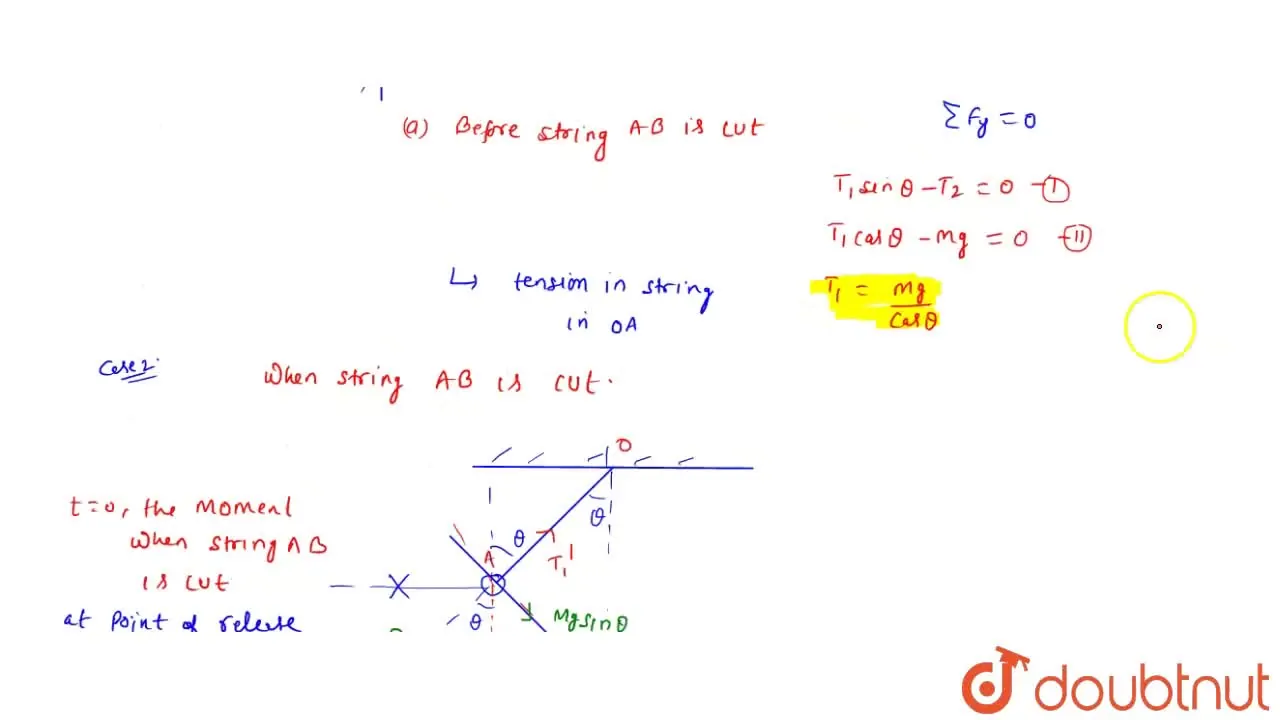Particle A is suspended by a string tied at point O from the roof of a room. The same particle is also tied to one of the walls of that room, at point B. Find the tension in OA before and after AB is cut.
Before cutting the rope it is a simple equilibrium problem.
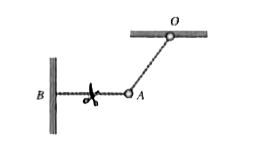 After cutting the rope the particle will move on a circular path. Our analysis for both situations has to be different.
After cutting the rope the particle will move on a circular path. Our analysis for both situations has to be different.
Calculatiions: Case 1: Consider the free body diagram of the particle before cutting. Resolving forces vertically and horizontally and applying equilibrium model
T1cosθ−mg=0
T1sinθ−T2=0
From eq we have
T1=mgcosθ
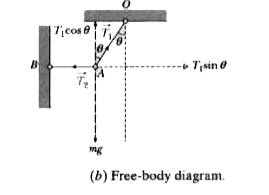
Case 2: Making new free body diagram after string is cut. Tension in the rope can change instantaneously. We cannot resolve forces in vertical and horizontal direction because acceleration of the particle is unknown. We can resolve forces along the length of rope and perpendicular to the rope. We know that radial acceleration of the particle will be zero as just after cutting the rope, particle remains at rest.
Learn: Writing Newton.s second law alon the string
T.1−mgcosθ=mv2l
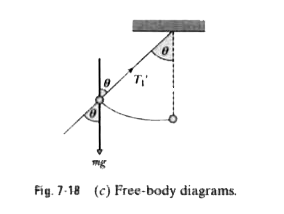
As v=0 after cutting
T.1=mgcosθ=0
In Case of: In case we want to write Newton.s second law in vertical direction, how do we go about it?
Calculations: It is easy to find that tangential acceletation at=gsinθ and we know ac=0 as centripetal acceleration is zero just after cutting. Taking component of forces and acceleration in vertical direction
mg−T.1cosθ=matsinθ
T.1cosθ=mg(1−sin2θ)
T.1=mgcosθ

Related Playlists
- BOOK - RESNICK AND HALLIDAYCHAPTER - CIRCULAR MOTIONEXERCISE - PROBLEMS56videos
CIRCULAR MOTION
- BOOK - RESNICK AND HALLIDAYCHAPTER - CIRCULAR MOTIONEXERCISE - PRACTICE QUESTIONS(SINGLE CORRECT CHOICE TYPE)40videos
CIRCULAR MOTION
- BOOK - RESNICK AND HALLIDAYCHAPTER - CIRCUITSEXERCISE - Practice Questions (Integer Type)3videos
CIRCUITS
- BOOK - RESNICK AND HALLIDAYCHAPTER - CURRENT AND RESISTANCEEXERCISE - Practice Questions (Integer Type)3videos
CURRENT AND RESISTANCE
Similar Questions
IF a stone is tied to one end of the string and whirled in verticle circle, then the tension in the string at the lowest point is equal to
View SolutionA particle of mass m is suspended from a string of length l fixed to the point O. What velocity should be imparted to the particle in its lowermost position so that the string is just able to reach the horizontal diameter of the circle?
 View Solution
View SolutionA unifrom rod of mass m and length L is kept on a horizontal table with L4 length on the table. The end B is tied to a string as shown in the figure. The string attached to the end B is cut and the rod starts rotating about point C. Find the normal reaction from the table on the earth as soon as the string is cut.
 View Solution
View SolutionA particle of mass ma is suspended from a ceiling thrugh a string of length L. The prticle moves in a horizontal circle of radius r. Find (a) the speed of the prticle and (b). the tension in the string. Sch a system is called a conical pendulum

.View Solution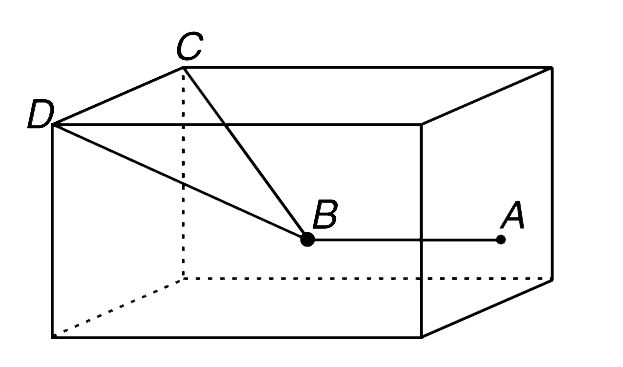
A room is in shape of a cube . A heavy ball (B) is suspended at the centre of the room tied to three inextensible strings as shown. String BA is horizontal with A being the centre point of the wall. Find the ratio of tension in the string BA and BC.View SolutionA pillar having square cross section of side length L is fixed on a smooth floor. A particle of mass m is connected to a corner A of the pillar using an inextensible string of length 3.5 L. With the string just taut along the line BA, the particle is given a velocity v perpendicular to the string. The particle slides on the smooth floor and the string wraps around the pillar.
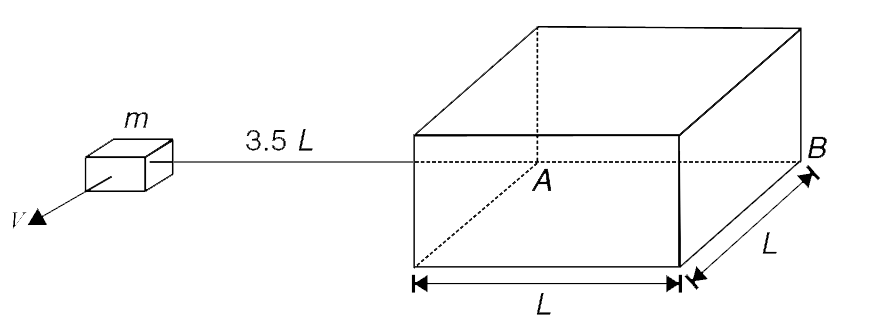
(a) Find the time in which the particle will hit the pillar. (b) Find the tension in the string just before the particle hits the pillar. Neglect any energy loss of the particle.View SolutionTwo identical small bodies each of mass m and charge q are suspended from two strings each of length l from a fixed point. This whole system is taken into an orbiting artificial satellite, then find the tensio in strings
View SolutionA particle of mass m=2 kg is suspended in a vertical plane by two strings - one horizontal and the other inclined to the vertical by α=30∘. Find the tension of the inclined string (a) an instant before the horizontal one is cut, (b) an instant after the horizontal one is cut.
View SolutionA particle is suspended by a light vertical inelastic string of length 1 from a fixed support. At its equilbrium position it is projected horizontally with a speed √6gl. Find the ratio of the tension in the string in its horizontal position to that in the string when the particle is vertically above the point of support.
View SolutionA heavy particle hanging from a fixed point by a light inextensible string of length l is projected horizonally with speed √gl . Find the speed of the particle and the inclination of the string to the vertical at the instant of the motion when the tension in the string is equal to the weight of the particle.
View Solution

